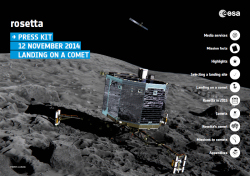ESA Science & Technology - Publication Archive
Publication archive
Publication archive
--- Remainder of abstract truncated due to character limitations ---
--- Remainder of abstract truncated due to character limitations ---
--- Remainder of abstract truncated due to character limitations ---
--- Remainder of abstract truncated due to character limitations ---
 |
Contents:
Media services
Mission facts
Highlights
Selecting a landing site
Landing on a comet
Comets – an introduction
Rosetta's comet
Missions to comets
Appendix A: Provisional programme for press event at ESOC
Appendix B: Selected images and videos
Appendix C: Distances, dates, times for mission
Appendix D: Timeline for separation
Errata
pg 48: a minus sign is missing from the temperature quoted. The text should read: "The average surface temperature, reported by the VIRTIS team, is -70 °C (205 K)"Press kit updated in October for Go for landing on the primary landing site.
Contents:
Media services
Quick reference mission facts
Highlights from the Rosetta mission thus far
Selecting Site J, a landing site for Philae
Landing on a Comet
Comets – an introduction
Rosetta's comet – at a glance
Missions to comets - Rosetta in context
Appendix A: Distances, dates, times for mission milestones
Exoplanets that orbit close to their host stars are much more highly irradiated than their Solar System counterparts. Understanding the thermal structures and appearances of these planets requires investigating how their atmospheres respond to such extreme stellar forcing. We present spectroscopic thermal emission measurements as a function of orbital phase ("phase-curve observations") for the highly-irradiated exoplanet WASP-43b spanning three full planet rotations using the Hubble Space Telescope. With these data, we construct a map of the planet's atmospheric thermal structure, from which we find large day-night temperature variations at all measured altitudes and a monotonically decreasing temperature with pressure at all longitudes. We also derive a Bond albedo of 0.18+0.07-0.12and an altitude dependence in the hot-spot offset relative to the substellar point.
This report, the so-called Red Book, provides a scientific, technical and management summary of the JUICE definition study that was performed from February 2012 to October 2014.
The JUICE (JUpiter ICy moons Explorer) mission has been selected by ESA in May 2012 to be the first large mission within the Cosmic Vision Program 2015-2025.
Ultra-compact dwarf galaxies are among the densest stellar systems in the Universe. These systems have masses of up to 2 × 108 solar masses, but half-light radii of just 3-50 parsecs. Dynamical mass estimates show that many such dwarfs are more massive than expected from their luminosity. It remains unclear whether these high dynamical mass estimates arise because of the presence of supermassive black holes or result from a non-standard stellar initial mass function that causes the average stellar mass to be higher than expected. Here we report adaptive optics kinematic data of the ultra-compact dwarf galaxy M60-UCD1 that show a central velocity dispersion peak exceeding 100 kilometres per second and modest rotation. Dynamical modelling of these data reveals the presence of a supermassive black hole with a mass of 2.1 × 107 solar masses. This is 15 per cent of the object's total mass. The high black hole mass and mass fraction suggest that M60-UCD1 is the stripped nucleus of a galaxy. Our analysis also shows that M60-UCD1's stellar mass is consistent with its luminosity, implying a large population of previously unrecognized supermassive black holes in other ultra-compact dwarf galaxies.
Aims. Approach observations with the Optical, Spectroscopic, and Infrared Remote Imaging System (OSIRIS) experiment onboard Rosetta are used to determine the rotation period, the direction of the spin axis, and the state of rotation of comet 67P's nucleus.
Methods. Photometric time series of 67P have been acquired by OSIRIS since the post wake-up commissioning of the payload in March 2014. Fourier analysis and convex shape inversion methods have been applied to the Rosetta data as well to the available ground-based observations.
Results. Evidence is found that the rotation rate of 67P has significantly changed near the time of its 2009 perihelion passage, probably due to sublimation-induced torque. We find that the sidereal rotation periods P1 = 12.76129 ± 0.00005 h and P2 = 12.4043 ± 0.0007 h for the apparitions before and after the 2009 perihelion, respectively, provide the best fit to the observations. No signs of multiple periodicity are found in the light curves down to the noise level, which implies that the comet is presently in a simple rotation state around its axis of largest moment of inertia. We derive a prograde rotation model with spin vector J2000 ecliptic coordinates λ = 65° ± 15°, β = + 59° ± 15°, corresponding to equatorial coordinates RA = 22°, Dec = + 76°. However, we find that the mirror solution, also prograde, at λ = 275° ± 15°, β = + 50° ± 15° (or RA = 274°, Dec = + 27°), is also possible at the same confidence level, due to the intrinsic ambiguity of the photometric problem for observations performed close to the ecliptic plane.
Final edit of article will appear later.
On September 26th, 2005, Cassini conducted its only close targeted flyby of Saturn's small, irregularly shaped moon Hyperion. Approximately 6 minutes before the closest approach, the Electron spectrometer (ELS), part of the Cassini Plasma Spectrometer (CAPS) detected a field-aligned electron population originating from the direction of the moon's surface. Plasma wave activity detected by the Radio and Plasma Wave (RPWS) instrument suggests electron beam activity. A dropout in energetic electrons was observed by both CAPS-ELS and the Magnetospheric Imaging Instrument Low Energy Magnetospheric Measurement System (MIMI-LEMMS), indicating that the moon and the spacecraft were magnetically connected when the field-aligned electron population was observed. We show that this constitutes a remote detection of a strongly negative (~ -200 V) surface potential on Hyperion, consistent with the predicted surface potential in regions near the solar terminator.
